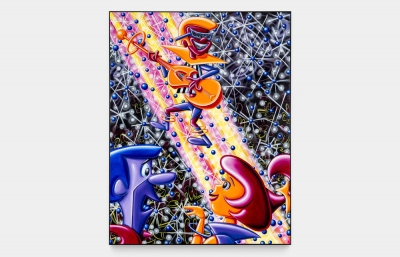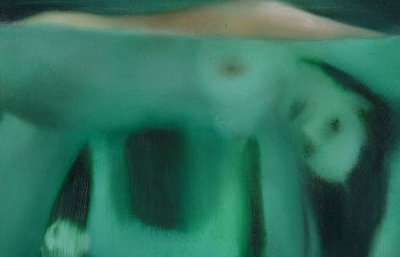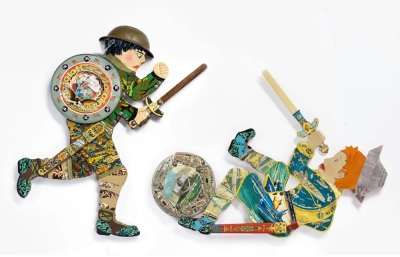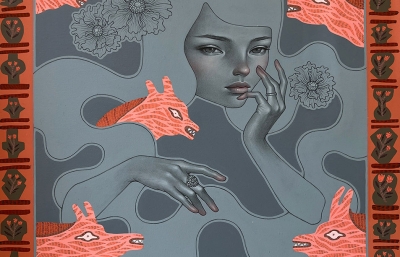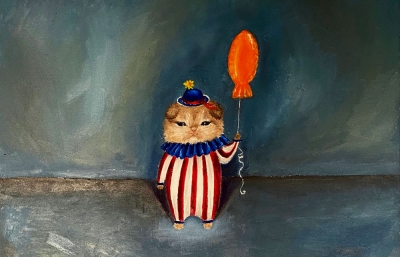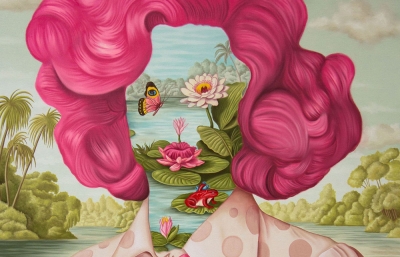On the occasion of Spotlight: Maud Madsen, on view at FLAG Art Foundation in NYC and focusing on Maud's work Backseaters, 2024, we will be speaking with the artist on Radio Juxtapoz in the coming weeks. For the show, there is a wonderful essay by Maria Vogel that we wanted to share today.

Not Taking a Backseat
By Maria Vogel
Recently, watching the two-and-a-half-year-old son of friends transported me to distant but still familiar memories from my own childhood. Since meeting him at just a few months old, I’ve witnessed his ever-evolving interests, noticing slight changes in what most captivates him as he grows—a first for me in my adult life. At present, he is filled to the brim with glee for fort building. So much so, his mother remarked that they shifted from building up and tearing down a new fort every day to permanently (at least for the time being) leaving a make-shift structure assembled in their sunroom. I spent a long weekend taking note of the distinct comfort this assemblage provided for the boy. While toys and other play areas abound in other corners of their home, this was the spot he darted to every morning, staying well into the afternoon unless another activity was proposed. When not there, he could often be found creating other versions of a fort; inviting you onto the couch to put a blanket over your heads, or in another pocket of space, offering that same sense of cover, or as I soon realized, safety.
Observing this ultimately fleeting phase of his life reminded me of my upbringing, now coupled with a renewed awareness of the need to create safe spaces for ourselves and others. Safety seeking, even that which is perceived, is ingrained in us from the time we enter the world. We grow up never straying too far away from its confines, blissfully unaware of what lies beyond the invisible boundaries of the realms we create.
In the painting Backseaters, 2024, and within Maud Madsen’s practice at large, the artist reflects on and unravels this tension-filled edge. Within Madsen’s universe, there are the before times, when girlhood felt shrouded in safety, and the after, when a keen realization of the world around her became impossible to overlook. Both parts hold equal weight in Backseaters, a painting that similarly exists as a distinct turning point for the artist.
Formally speaking, Backseaters is Madsen’s first foray into large-scale oil painting. As though putting herself through a self-imposed training season, she withheld entering this arena until she had the time and space to intimately work with and understand the medium. Madsen is a calculated and disciplined artist; within her practice, she studies what she is doing and how she is doing it intimately before moving onto something else. If she makes a move in the studio, it has to be the right move, occurring at the right time.
Backseaters features the largest grouping of figures Madsen has included in a single scene. Perhaps more significant than the number, is the nod to the artist’s own life; Madsen is one of four girls, a sibling unit that holds a leading role in the story of her adolescence, childhood, and entry into girlhood. Her earliest memories are rooted in the rural area of Pennsylvania where she lived until middle school. Listening to Madsen describe this foundational chapter of her life rings idyllic: running through sprawling forests, exploring a world that belonged to no one apart from her and her siblings. This is Madsen’s before time, her fort, her safety.
The move from rural Pennsylvania signified not just a change in where she was first tethered to the earth, but a directional change toward adulthood. Though her surroundings might have taken on new form, what remained was Madsen’s proximity to her sisters. Together, they share the experience of exiting a sheltered, harmonious existence to one more open to outside influence.
This polarity shrouds the environment we encounter viewing Backseaters. The figures have an obvious bind to girlhood, evident through their posture, the clothing they wear, and even the setting itself. Despite this, Madsen blurs anything that would indicate absoluteness. Their physical appearance does not provide any answer as to their precise age; what we see of their faces does not tell us if it is four versions of the same person or separate individuals. With the backward-facing perspective, what we can say for certain is that we are watching them, our gaze is planted upon unknowing girls amid car-ride slumber. This is Madsen acknowledging her after; she is reflecting on her past not as an idealistic utopia, but instead approaching it with a discerning, realistic lens. Rather than lamenting something as memory-provoking as a road trip from a perspective built in the past, the artist inserts her present self and the awareness she’s gleaned with age.
The expression “two things can be true at once” echoes within the sea of red created by stretches of taillights. Madsen’s backseat is a space of safety, of comfort, and of a shared moment we often yearn for as the years pass by. It is also a venue teetering on the reality of outside forces, that upon entering, seem to have a permanent stay in your mind’s eye. Backseaters is the before, the after, and all the liminal spaces that exist within the inevitable (unstoppable) transition from the beginnings of life into all that comes with time.



